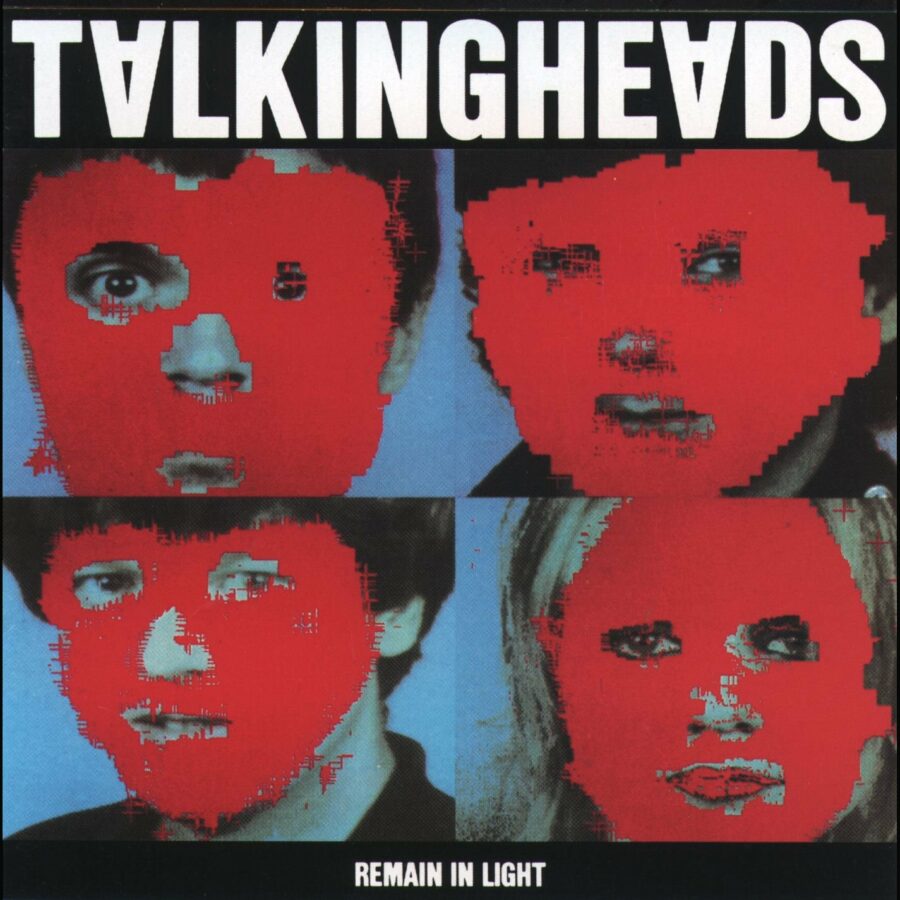The Talking Heads’ ear for new genre collages can be tracked from their first record, to their last, but through a clever usage of afrobeat, electronics, and new recording philosophies, 1980’s Remain In Light continues to stand out as one of the most creative records in their catalogue, and maybe of all time. After their humble-but-wild beginnings alongside the Ramones and Blondie at CBGB, Talking Heads became a staple within both the punk and new wave scenes. Their horizons kept expanding through all of their first three full-length releases, exploring areas of funk and psychedelia, but nothing would compare to the numerous musical shifts made on Remain In Light; most of which would continue to define them over the next ten years.
In a concerted effort to clash the ideas of western rock with the then-blossoming worldbeat, a majority of the instrumentals on this record are composed of short, isolated licks, picked from longer grooves, and constantly looped. This was specifically unique at the time, requiring them to do most of it manually due to the constraints computers were still under. Lead singer, David Byrne, compared this to modern sampling, claiming they “were human samplers.” But the end result of their patience, and willingness to experiment with this recording style, is a record filled with mind-blowing, heavily-layered sonic bases.
“Born Under Punches (The Heat Goes On)” begins with an already-cluttered sound of funk-based, staccato guitars, that only features brief variation in the form of futuristic beeps. “Crosseyed and Painless” follows similar trends, this time much more rhythm-driven, with a strong bass, and a large variety of percussion. The African music influences then come to a peak on “The Great Curve,” which is to-this-day one of the most strangely cohesive ideas in music. It melds quick, subtle, tropical, acoustic percussion with long, distorted guitar riffs that could be featured on a Van Halen record. The way it develops manages to be just as intriguing, with short bursts of human voices layered over each other, until they create their own kind of melody by the end.
While this record is great at constructing crazy, complex tracks rooted in international influences, it also includes two of their most commercially successful songs, in “Once in a Lifetime” and “Houses in Motion.” The aforementioned rhythmic patterns and instrumental loops still find themselves featured on both of these, but manage to hide behind a more pop-friendly, post-punk and new wave sound. “Once in a Lifetime” is just as fun as it is wild, with bright, twinkling guitars, and numerous synthetic additions. “Houses in Motion” juxtaposes the fast pace and full sound of its predecessor, with very slow, minimal production for large portions of the track, to the point of sounding like a funky Joy Division during the beginning moments. And of course, both of these tracks manage to be heavily dominated by the personality and performance of a sporadic David Byrne.
As Byrne still managed to front the group quite effectively, Remain In Light brought out a much different man than audiences were used to at the time. As he was supposedly struggling with writer’s block during the creation of this record, a lot of the lyrical themes and styles are very flow-of-thought oriented. The clearest example might just be on “Once in a Lifetime,” with its eccentric, curious, but still-coherent questions. Another good sample comes from the opener, “Born Under Punches (The Heat Goes On),” when Byrne either blurts random statements out, like “I’m so thin,” or wildly addresses the audience, saying, “Some ‘a you people just about missed it!” The fourth-wall breaking elements of some of these tracks has expanded since then, to several bands, specifically Car Seat Headrest. And while it’s pretty certain Byrne didn’t solely create this way of writing, it is a very prominent and noteworthy part of this record.
One thing that’s missing in Remain In Light is a singular, centric theme to tie it all together, however, in a way, that aids most of the content displayed. With the wild and eclectic mashing of source content, and the sometimes insane-sounding Byrne, the record doesn’t know what it is, but is, as a result, a masterpiece of a mess. Almost every section of their fourth studio album is meticulously pieced together, but it’s hard to be straight-forward when it’s so all-encompassing, so it’s hard to state that as a fault.
Thirty years after its initial release, Remain In Light is still a one-of-a-kind LP. The heavy focus on experimental compositions and outlandish lyrics makes it a very cluttered, but beautiful mess. Very few artists have successfully fused western, technology-filled musical styles with acoustic, rhythm-based African music, even in the 21st century, proving just how hard it is. The perseverance shown in the record of this, and the writing on Byrne’s side, is not just impressive, but is rewarded in its own product. It also brought forth the “worldly” sounds of the Talking Heads’ future, that they would later explore throughout the ‘80s.
Advertisement
Advertisement
